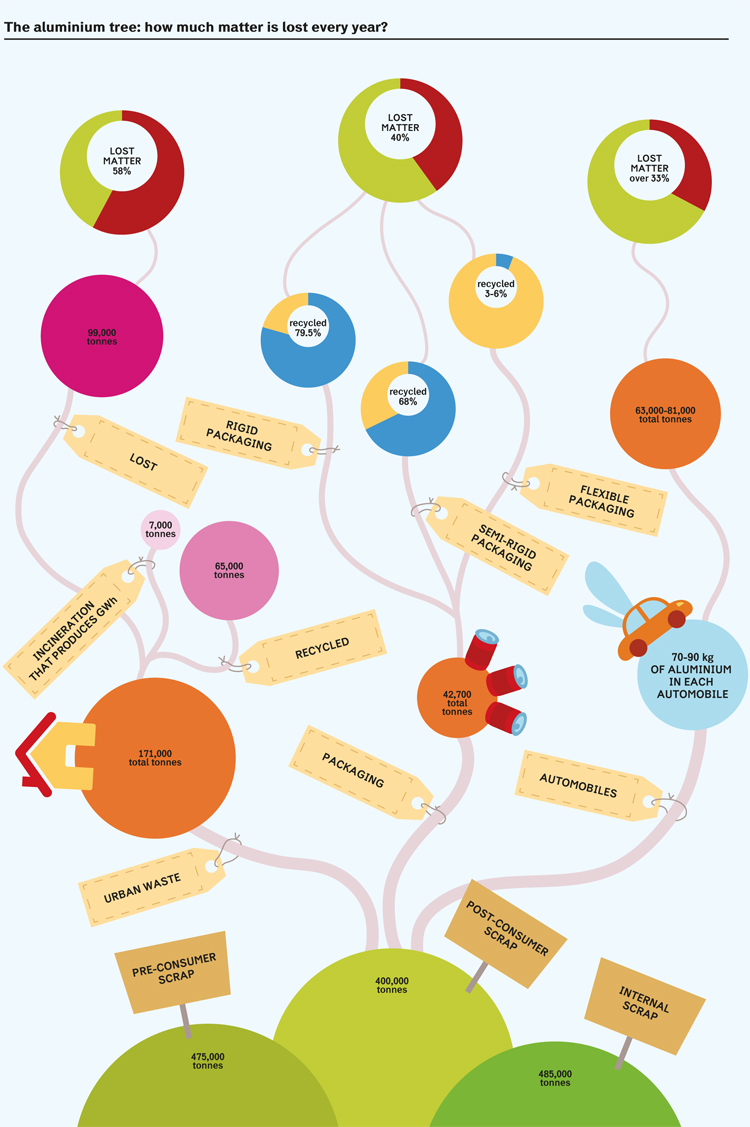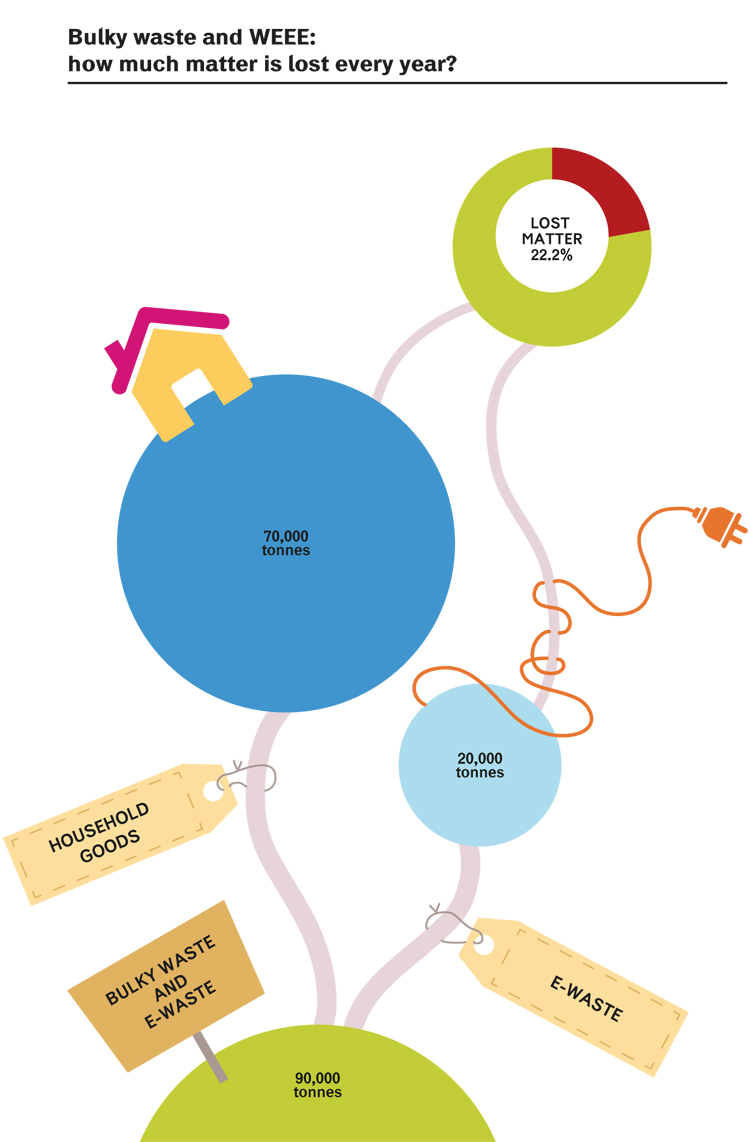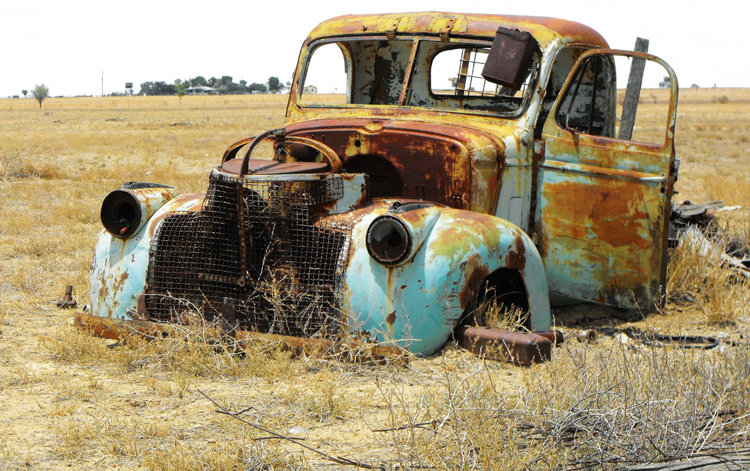This article is condensed from the study Le miniere urbane dell’alluminio (Urban Mining of Aluminium) produced by CiAl – Consorzio imballaggi alluminio (Aluminium Packaging Consortium) (forthcoming).
After Germany, Italy is the second largest producer of aluminium in Europe. Italy is also the leader in the production of secondary – that is, recycled – aluminium. And yet the “urban mines” of discarded aluminium are still to exploit.
Historically, Italy’s production of aluminium is based on scrap, and as of 2013 the country produces only secondary aluminium. Of the 1.15 million tonnes of ingots produced that year, some 42% was secondary aluminium from smelters and 58% secondary aluminium from refiners (with a high ratio of post-consumer recycled materials).
The manufacturing of semi-fabricated products is made up of 44% castings, 30% laminates, and 26% extrusions and drawings. The aluminium is used in engines and transportations (primarily castings), construction (particularly extrusions), the production of sheet and packaging (laminates), products for the home or office, and in machinery.
Most, if not all, semi-fabricated and finished products come from secondary aluminium alloys, the nation’s only aluminium manufacturing.
The manufacturing chain for aluminium recycling in Italy consists of the following activities:
- recovery of scrap (differentiated waste collection, sale, processing of post-consumer waste of national origin);
- refining and remelting for the production of secondary aluminium (in billets, plates, slabs, molten liquid);
- manufacturing of malleable semi-fabricated aluminium (extrusion, lamination, forging) – which is recorded alongside refining and remelting – and casting with production of ingots (later transformed into finished products).
Overall, the combined value of production in these three phases surpasses 7 billion euro, and employs approximately 24,000 workers.
There are three types of scrap that fuel the production of secondary aluminium.
1) Post-Consumer Scrap is made up of old waste, including filings or other fragments and scrap derived from demolition, discarded products, or differentiated waste collection. It is estimated to constitute approximately 400,000 tonnes, of which less than 70,000 are derived from urban waste (2013 data).
2) Pre-Consumer Scrap (commercial) is made up of cleaned and new ingots, both from the production of semi-fabricated product and manufacturing by-products (turnings, cuts, not to spec or rejected materials). As of 2013, this was estimated to constitute 475,000 tonnes of pre-consumer scrap.
3) Internal Scrap (non-commercial) from production processes, constituted by the recovery of dross and salt cake left over from the production of ingots, laminates, and extrusions in integrated processes; these flows are statistically irrelevant and are estimated at 485,000 tonnes in 2013.
Only a portion of these secondary materials is collected domestically: in fact, Italy is also a major importer of aluminium scrap. So much so that, in 2013, the country’s trade balance in this sector registered a deficit of more than 340,000 tonnes and 426 million euro.
But even now the great mines of secondary aluminium – industrial scrap on one side, post-consumer wastes on the other – possess an intrinsically high economic and environmental value. If manufacturing (“pre-consumer”) waste is almost completely reused, it appears more difficult – currently – to reconstruct the flows of post-consumer waste. It should also be kept in mind that there is a large “grey” area of recovered and sold material that eludes measurement for tax reasons.
One indicator concerns the quantitative dimension of post-consumer waste, estimated today to lie between 400,000-500,000 tonnes annually.
The post-consumer waste and scrap that comes from various applications includes 100% aluminium products (for example packaging or wire) as well as components of other products (like automobile parts or electronic appliances).
Not all these wastes – on the surface, at least – are actually recovered. Indeed, the “urban mines” of aluminium still seem to be quite full. The overall loss of aluminium from urban and industrial areas is estimated at around 40%.
But in certain realms it is higher still: including 58% of all urban flows, 40% of packaging, and 33% of automobiles at the end of their life cycle.
Significant waste and loss of material can be found above all in urban contexts: only a small portion of aluminium foil or other flexible and semi-rigid packaging are ever recycled; the story is the same for furniture and other household goods, as well as components of other waste like electrical appliances and electronics or aluminium dross from incineration.
Urban waste contains some 171,000 tonnes of aluminium, of which less than one half is made of up packaging. The amount recorded under “hygiene and household use” also includes small amounts typically from furnishings and bulky items.
Separate waste collection and the sorting and recovery of residual waste accounts for approximately 65,000 tonnes recycled every year, around only 38%. Additional recovery of aluminium flows outside urban waste chains – from furnishings, for example – may be higher, but this is impossible to ascertain or to verify.
Then there are the approximately 7,000 tonnes of aluminium that are subject to incineration, directly or via SRFs (Solid Recovered Fuels), producing 11 GWh.
Thus, on the basis of available data there appears to be a loss of aluminium equivalent to approximately 99,000 tonnes/year, equal to 58% of the waste produced.
According to data from the CiAl, the recovery of aluminium packaging – not including its separation into an appropriate receptacle – is equal to approximately 42,700 tonnes, which can be attributed almost completely to urban recycling. The reuse of material from aluminium packaging (estimated on the basis of data from the CiAl, which represents 25% of waste collected) is composed of 97% of packaging from differentiated waste collection and the remainder from the separation of residual waste (in TMB – Thermal or Mechanical-Biological treatment – and dross).
If the rate of recovery of post-consumer waste is very high in terms of cans and rigid packaging (79.5%) or even semi-rigid (68%) it is decidedly low with respect to flexible packaging (3-6%), which is not reused either because it is not collected separately or because it is not adequately sorted by ECS technology (Eddy Current Separators) on conveyor belts of mixed materials or other mechanical-biological treatment processes.
All told – and also considering the recovery of dross and the energy conversion of some aluminium – it turns out that 40% of the material contained in packaging and other products is still to recover.
But, above all, the recovery of other flows present in urban waste is very modest.

Bulky waste and e-waste make up less than 20,000 tonnes gathered annually, compared with an annual consumption of approximately 70,000 tonnes of household goods (distinct from packaging and foil) and roughly 20,000 tonnes/year contained in e-waste.
Here the losses are even greater: apparently some 76% of aluminium in discarded household goods is lost, as is 68% of aluminium contained in e-waste.
Another source of loss can be found in dross: the effective current capacity recovered is equal to a little more than 10% of its theoretical potential.

A great deal of material is also lost from automobiles – one of the primary sources of recovered aluminium. The amount of aluminium that goes into automobiles has continued to increase over the years. Estimates from the 1990s – the period when the averaged junked vehicle was manufactured – indicate that each automobile contains approximately 70-90 kg of aluminium. As a result, the theoretical content of all vehicles scrapped in 2012 can be estimated to be in the range of 63,000-81,000 tonnes.
Compared to this theoretical total, the sum of all non-ferrous scrap (including copper and lead) recorded as being recycled is equal to only 10,591 tonnes.
Even considering the amount of undefined recycled scrap (69,000 tonnes, of which, by analogy with countries like Germany, France, or Spain, we might estimate to contain approximately 60% of non-ferrous metals), the total of non-ferrous scrap can be estimated at around 53,000 tonnes, of which nearly 80% is aluminium, equivalent to roughly 42,000 tonnes per year, between one-half and two-thirds of the estimated total.

Though based solely on estimates, the amount of waste here appears to be very significant, and marks an important potential unexploited aluminium flow, somewhere on the order of 40%.
Thus, the recovery of aluminium waste also presents great potential for other sectors in addition to packaging (where more than 70% is recuperated today).
Top image: Illustration from the play Snow White and the Seven Dwarfs, 1913


